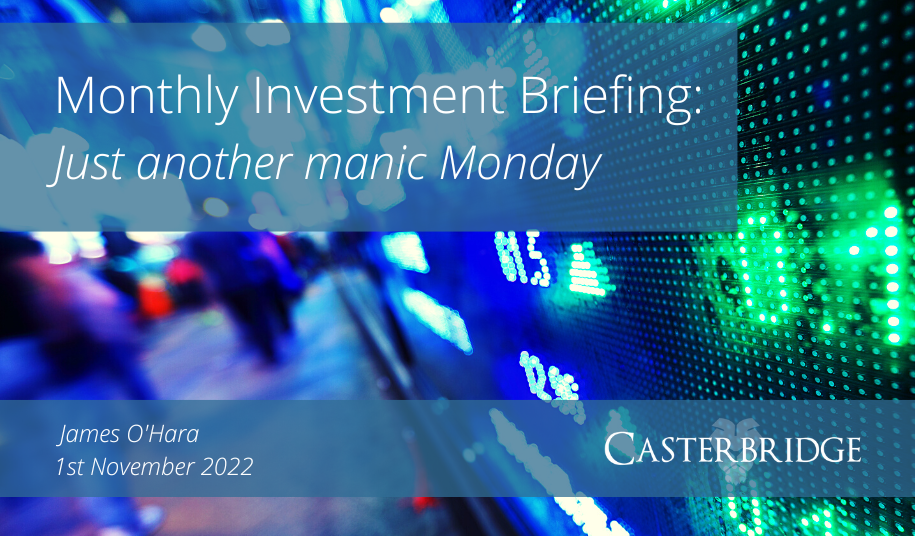Key Events in October
- Fed Rate Rises and Stickier inflation due to the ‘Wealth Effect’ and its unwinding
- Although rent and employment numbers are starting to come down
- Falling energy prices and stronger inventories
- UK Political Merry-go-round and mini budget reversal
- Sterling recovery vs USD
- Company Earnings – a mixed bag but still growing rather than contracting.
- Bear market rally or market bottom…?
- Soft landing still possible? Fed Pivot? More likely a pause is on the cards.
Just another manic Monday…
I would like to caveat this commentary by saying this was written in the last week of October. Given the pace of news flow we’ve, I apologise for not including any subsequent political calamity/market altering news we may see in the subsequent days…
We have now seen 3 Prime Ministers within a 50-day period as Liz Truss’ tumultuous, yet brief tenure came to a stuttering end this month. Rishi Sunak, who ironically lost the initial race to Truss, is now in charge and attempting to restore faith in government and the UK economy. Kwasi Kwarteng’s snap mini budget reversal, which almost brought the UK pension sector to its knees has restored some faith, albeit after a sharp intervention by the Bank of England to repurchase gilts to stabilise falling prices. Political Merry-go-round aside, across the pond we saw the FED raise rates by another 0.75% as another monthly CPI print came in slightly hotter than expected. Probability has now increased that there’ll be a further 0.75% rise at the subsequent FED meeting, with the likelihood of a FED pivot (moving to lowering rates) now diminishing. It now looks more likely that we’ll see a pause going into 2023, with central banks assessing how higher rates do in fighting inflation. There does tend to be a 9–12-month lag before the real effect of higher rates feeds through to the economy. It is easier to take a more hawkish stance in the face of persistent inflation, it will be less so in 2023 when employment is on the rise with a weakening economy.
Inflation has been ‘stickier’ for 2 main reasons – the tight labour market and reversal of the ‘Great Resignation’ and the persistence of household rents. There’s a term called the Wealth Effect which details how, particularly in the US, citizens rely on capital rather than income. This has been reinforced during the Covid period where spending dropped, helicopter payments came through the post and investing increased (The GameStop drama personified this). Investment capital was extremely positive coming into this time last year and the savings rate has been extremely strong. This has allowed households to continue spending despite higher inflation and energy costs which has led to a persistent CPI print. The labour market has also been extremely tight, and unemployment has been at its lowest, at least in the UK, since the 1970s. Higher inflation has made some of the population think twice about early retirement, as well as the reversal of the ‘Great Resignation’, which saw many people down tools for early retirement sitting on large investment gains. Fast forward a year and we’ve since seen much higher inflation and a persistent bear market which has forced the hand of many who have had to return from tropical beaches back to the workforce.
However, in recent days we’ve seen positive news flow on energy prices coming way down thanks to strong inventories and milder Autumn/Winter thus far. Shipping costs have returned to pre-pandemic levels and company inventories are so strong, large discounts are being applied to current stock to reduce this as seen from Nike’s recent results – (should be a good Black Friday this year if you’re in the market for a telly). Even the stickier indicators like wage growth and rents, thanks to higher mortgage rates putting off buyers and landlords alike, are now starting to rollover, suggesting inflation is gradually being tempered.
How the Markets Reacted:
Markets are seemingly trying to find a level after all the recent volatility, and it certainly feels like green shoots are beginning to emerge. The indices themselves have been trying to find a reason to grind upward, and at the time of writing, since the start of October the FTSE is up 2.43%, the S&P 500 is up 6.92% and the MSCI All World sitting in the middle at 5.3%. The FTSE has been buoyed by utilities, mining and energy – particularly as BP and Shell form 17% of the FTSE 100. The S&P 500 has been slowly meandering down in response to higher rates from the FED, but at current levels (3820), there’s still some way to go to retest the 2020 lows. The current fair value P/E ration for the S&P 500 – based on a model using the 2-year nominal yield and 10-year real yield as inputs, is now about 13.5 times expected earnings, as reported by Fidelity[1]. This would equate to a level of 3200 for the S&P 500 – a roughly 10% decline from here. The caveat for this is indeed that the earnings being reported remain stable and don’t see large revisions down. We are currently the thralls of earning season this week and so far we’ve seen, unsurprisingly, great results within the energy sector as BP and Shell recorded record profits while raising dividends. In the US, giants Alphabet (Google) and Microsoft posted growth slowdown in their core sectors, sparking a sell off – even the generals get shot in the end. We were expecting slower growth across the board rather than a contraction and it seems the earnings are holding up in the midst of higher rates – at least for now.

The unwinding of the mini-budget and Rishi Sunak’s appointment has also provided a much needed reprieve for the Sterling, as it is now trading at £1.15 vs USD, up from near parity in late September. This movement upwards definitely makes us more sanguine about buying back into US assets after the recent dollar rally. Our ideal range to be currency agnostic, particularly at current market levels, would be between 1.20 and 1.25. The risk in buying into US assets needs to be right as any currency appreciation will work against us and fight any appreciation in share price.
Assura Move Update and Positioning Outlook
We are pleased to confirm that assets have been safely migrating across in, settling in stages this week. We hope to issue everyone with their new portal logins to be able to view your assets, whilst we do our final reconciliations. We still remain tactically underweight to global equities, but we plan to utilise this cash and feed it back into the markets in tranches, much like we did pre-migration. Our key themes still centre around Healthcare, Technology and growing GDP within the emerging markets. We are still aware of potential pitfalls, particularly surrounding contracting liquidity in the bond markets, but at current valuations we believe there are opportunities for long term growth. We will be looking to reduce the active tactical position in cash we took into the migration and putting this cash to work, starting in areas of the market that look attractive – currency dependent of course. We will be aiming to achieve a portfolio yield of 3-4%, mandate dependent, over the coming months to benefit from the higher interest rates and ensuring this part of the portfolio keeps pace with the market rate, before any capital appreciation. Higher Gilt yields will allow us to achieve this more sustainably without the need to take further undue equity risk.
Final Thoughts:
Whilst October has not brought about the price volatility that September did, there still remains precipitous risk within markets given the need for monetary policy involvement. However, we are seeing early indications that inflation is starting to be tamed, seller exhaustion and green shoots of growth. Earnings have thus far been solid and although slowing, they aren’t showing signs of contraction. We are pleased with the active decisions we have taken to shelter clients from the storm. Unfortunately, when it rains we all tend to get at least a bit wet, but we are pleased to have used our active management to prioritise keeping our clients dry. Our attentions now turn to putting this cash to work in order to provide sustainable capital growth over the long term.
Important Information
This article is for information only and does not constitute advice or recommendation and you should not make any investment decisions based on it. The views and opinions of this article are those of Casterbridge at the time of writing and may change without notice. Any opinions should not be viewed as indicating any guarantee of return from investments managed by Casterbridge nor as advice of any nature. It is important to remember that past performance and the value of an investment, and any income from it, may go down as well as up and the investor may not get back the original amount invested.
[1] https://www.fidelity.com/learning-center/trading-investing/dont-sell-now





